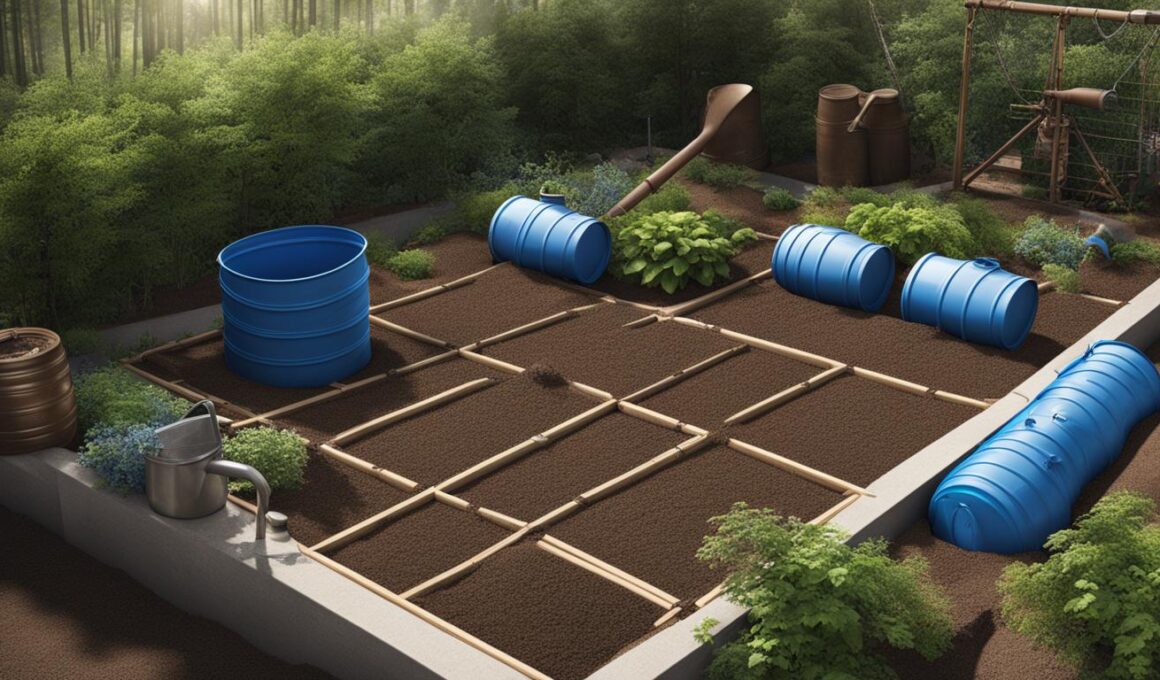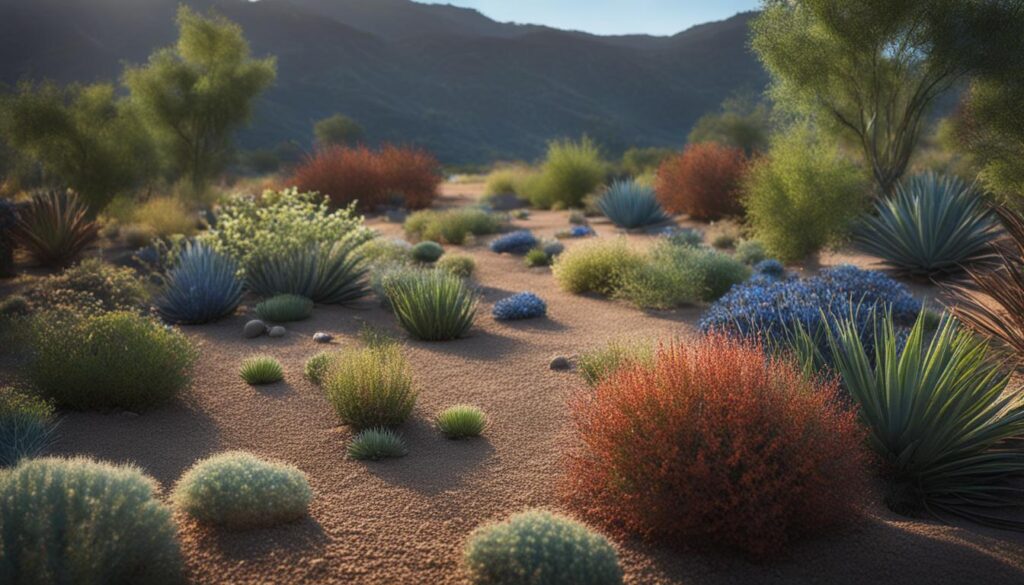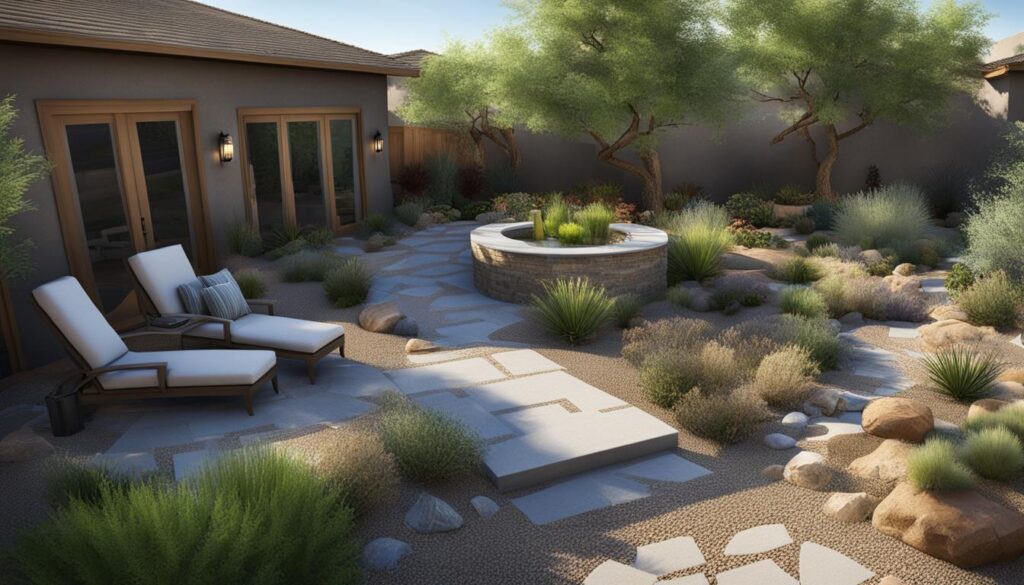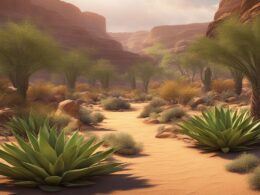Xeriscaping is a systematic method of promoting water conservation in landscaped areas. It involves planning, designing, and implementing strategies that reduce the need for excessive watering in arid regions. This guide will provide you with essential techniques for maximizing soil water storage in xeriscapes to ensure the successful growth and maintenance of your landscape.
Xeriscaping is a popular approach to landscaping in arid regions. By implementing the right techniques, you can create a beautiful and sustainable landscape while conserving water resources. This guide will walk you through the principles and practices of xeriscaping, with a focus on soil water storage techniques. Whether you are a beginner or an experienced gardener, this essential guide will equip you with the knowledge to transform your xeriscape into a thriving oasis.
Key Takeaways
- Understanding evapotranspiration rates is crucial for determining your plants’ watering needs.
- Improving soil’s water-holding capacity through organic matter and soil amendments is vital for successful xeriscaping.
- Efficient irrigation techniques, such as drip irrigation and rainwater capture, help conserve water in xeriscapes.
- Choosing drought-tolerant and native plants minimizes water requirements for your xeriscape landscape.
- Mulching conserves moisture, prevents soil erosion, and reduces weed growth in xeriscapes.
Understanding Evapotranspiration and Watering
Evapotranspiration (Et) is a crucial factor to consider when determining the watering needs of your plants in a xeriscape. This process involves the evaporation of water from the soil and the transpiration of water through plant leaves. By understanding Et rates in your area, you can effectively plan your irrigation schedule and ensure that your plants receive the appropriate amount of water.
Watering your xeriscape in the early morning when evaporation rates are low can optimize water efficiency. By doing so, you can minimize water loss due to evaporation and allow the soil to be replenished with the necessary water for your plants. This timing also allows the foliage to dry quickly, reducing the risk of fungal diseases.
To determine the Et rate in your area, consult local weather data, or use an evapotranspiration calculator. These tools take into account factors such as temperature, humidity, wind speed, and solar radiation to estimate the amount of water lost through evapotranspiration. By utilizing this information, you can ensure that your xeriscape is watered effectively and efficiently, reducing water waste and promoting healthy plant growth.
| Benefits of Understanding Et | Best Practices for Watering |
|---|---|
| • Allows you to determine the watering needs of your plants accurately. | • Water your xeriscape in the early morning when evaporation rates are low. |
| • Helps you plan your irrigation schedule to optimize water efficiency. | • Use an evapotranspiration calculator to determine the Et rate in your area. |
| • Reduces water waste by providing the appropriate amount of water to your plants. | • Consult local weather data for accurate information on temperature, humidity, wind speed, and solar radiation. |
Quote:
“Understanding evapotranspiration rates in your xeriscape is essential for efficient watering. By aligning your irrigation schedule with low evaporation periods, you can optimize water usage and promote a thriving, water-wise landscape.”
Xeriscaping Principles for Water Conservation and Efficient Landscaping Strategies
Xeriscaping, a method of landscaping that focuses on water conservation in arid regions, follows seven essential principles. By implementing these principles, you can create an environmentally friendly and visually appealing landscape that minimizes water usage and maintenance requirements. Let’s explore each of these principles:
1. Planning and Design
The first step in xeriscaping is careful planning and design. Consider the layout of your landscape and evaluate factors such as sun exposure, soil type, and natural drainage patterns. By analyzing these elements, you can determine the best placement for plants and utilize water efficiently.
2. Selecting and Zoning Plants
Choosing the right plants and grouping them based on water needs is crucial in xeriscaping. Opt for native and drought-tolerant plant species that have adapted to arid conditions and require less water. By zoning plants according to their water requirements, you can tailor your irrigation efforts and minimize water wastage.
3. Limiting Turf Areas
Turf areas, such as lawns, typically require excessive watering. To conserve water in xeriscaping, limit the use of turf and replace it with low-water alternatives. Consider incorporating ground covers, gravel pathways, or native plant beds, which can add visual interest while reducing water consumption.
4. Improving Soil Water Absorption
Enhancing the soil’s ability to absorb and retain water is essential in xeriscaping. Amending the soil with organic matter, such as compost, can improve its water-holding capacity. This allows for better root growth and reduces water runoff, ensuring that water is efficiently utilized by plants.
| Xeriscaping Principles | Benefits |
|---|---|
| 1. Planning and Design | – Utilizes sun exposure and natural drainage patterns – Maximizes water efficiency |
| 2. Selecting and Zoning Plants | – Chooses native and drought-tolerant species – Tailors irrigation to water requirements |
| 3. Limiting Turf Areas | – Reduces water consumption – Adds visual interest |
| 4. Improving Soil Water Absorption | – Enhances water-holding capacity – Reduces water runoff |
These principles form the foundation of xeriscaping and can help you create a sustainable and water-efficient landscape. By implementing them, you can conserve water resources while maintaining a beautiful outdoor environment.
Image source: https://seowriting.ai/32_6.png
Improving Soil for Water Retention
One of the key factors in successful xeriscaping is improving the soil’s ability to absorb and retain water. By enhancing the soil’s water-holding capacity, you can create a foundation for healthy plant growth and minimize water runoff. There are several techniques to improve soil for water retention in xeriscapes, including:
- Adding organic matter: Incorporating organic matter such as compost or well-rotted manure into the soil can significantly improve its water-holding capacity. Organic matter helps to create pore spaces in the soil, allowing it to retain water for longer periods and reducing the need for frequent watering.
- Amending clay or sandy soils: Depending on your soil type, certain amendments can be beneficial for improving water retention. For clay soils that tend to become compacted, adding coarse sand or perlite can help improve drainage and prevent waterlogging. On the other hand, sandy soils can benefit from the addition of organic matter or peat moss to increase their moisture-holding capacity.
- Creating water-holding basins: In areas where water tends to drain quickly, creating shallow basins or depressions around plants can help capture and retain moisture. These basins act as reservoirs, allowing water to slowly soak into the soil and reach the plant’s root zone.
By implementing these techniques, you can create a soil environment that maximizes water storage and promotes efficient water use in your xeriscape. Regularly monitoring soil moisture levels and adjusting your watering practices accordingly will further optimize water retention and ensure the long-term success of your water-wise landscape.
Image source: https://seowriting.ai/32_6.png
Efficient Irrigation Techniques
Efficient irrigation techniques play a crucial role in water conservation and sustainable xeriscaping practices. By implementing these techniques, you can minimize water wastage and ensure that your xeriscape landscape receives the right amount of water for optimal plant growth.
One effective technique is drip irrigation, which delivers water directly to the root zones of plants. This method minimizes water evaporation and eliminates water runoff, resulting in more efficient water usage. Drip irrigation also reduces the likelihood of weed growth by targeting water only to the intended plants, preventing moisture from reaching weed seeds. This technique not only conserves water but also saves you time and effort in weeding.
Another efficient irrigation technique is the use of rain barrels to capture and utilize rainfall. You can connect your gutters to rain barrels, allowing you to collect and store rainwater for later use. This water can supplement your irrigation needs, reducing the reliance on external water sources and helping to conserve water. Utilizing roofline runoff is another option to consider, as it provides a natural and sustainable way to water your xeriscape landscape.
Benefits of Efficient Irrigation
- Conserves water resources
- Reduces water wastage
- Promotes healthier plant growth
- Minimizes weed growth
- Saves time and effort
By implementing efficient irrigation techniques, you can contribute to water conservation efforts and create a more sustainable landscape. These techniques not only benefit the environment but also help you save on water bills and maintenance costs. Embracing efficient irrigation practices is a key component of successful xeriscaping and ensures the long-term health and beauty of your landscape.
| Technique | Benefits |
|---|---|
| Drip irrigation | Reduces water evaporation Minimizes water runoff Targets specific plant roots |
| Rain barrels | Collects and stores rainwater Supplements irrigation needs Reduces reliance on external water sources |
| Roofline runoff | Utilizes natural water source Minimizes water wastage Contributes to water conservation |
Selecting Drought-Tolerant Plants
When it comes to xeriscaping, choosing the right plants is crucial for water-wise landscaping. Opting for drought-tolerant plants is key to reducing water consumption and ensuring the sustainability of your xeriscape. These plants have evolved to thrive in arid conditions, making them ideal for water-efficient landscapes.
Native plants are particularly well-suited for xeriscaping as they have adapted to the local climate and require minimal water once established. Researching native plant species in your region will help you identify suitable options for your xeriscape. Look for plants with low water requirements, deep root systems, and the ability to withstand periods of drought.
In addition to native plants, there is a wide variety of non-native drought-tolerant species that can thrive in xeriscapes. Succulents, such as agaves and sedums, are popular choices due to their ability to store water in their leaves. Ornamental grasses, like fountain grass and blue fescue, are also excellent options as they are adapted to dry conditions and require minimal watering.
Benefits of Drought-Tolerant Plants
“Drought-tolerant plants not only conserve water but also offer numerous benefits for xeriscapes. These plants require less maintenance, as they have evolved to withstand harsh environmental conditions. They also attract pollinators, support local ecosystems, and add visual interest to your landscape.”
By incorporating a diverse selection of drought-tolerant plants, you can create a visually stunning xeriscape that thrives with minimal water usage. Keep in mind the specific water needs of each plant when designing your landscape layout to ensure optimal growth and water conservation.
Figure 6: Drought-tolerant plants add beauty and sustainability to xeriscapes.
Mulching for Water Conservation
Mulching plays a vital role in water conservation in xeriscapes. Applying a layer of organic mulch around plants helps retain moisture, prevents soil evaporation, and reduces weed growth. Mulching also protects plant roots from temperature fluctuations and improves soil health, contributing to the overall success of your xeriscape.
The Benefits of Mulching
When you mulch your xeriscape, you create a protective barrier that helps to retain moisture in the soil. This is especially important in arid regions where water is scarce. By preventing the evaporation of water from the soil surface, mulching helps to conserve water and reduce the frequency of irrigation. Additionally, mulching suppresses the growth of weeds, which compete with your plants for water and nutrients. With fewer weeds to contend with, your xeriscape plants can thrive and make the most of the available water resources.
Furthermore, mulching insulates the soil, providing a buffer against extreme temperatures. This is particularly beneficial in areas with hot summers and freezing winters. Mulch helps to regulate soil temperature, preventing plant roots from being exposed to excessive heat or cold. By providing a more stable environment for your plants, mulching promotes healthy growth and reduces stress.
Choosing the Right Mulch
When selecting mulch for your xeriscape, consider using organic materials such as wood chips, straw, or compost. These natural mulches break down over time, enriching the soil with organic matter and improving its overall structure. They also enhance the soil’s ability to retain water, promoting optimal conditions for plant growth. Avoid using inorganic mulch materials such as rocks or rubber, as these can create problems with heat retention and water absorption in your xeriscape.
| Mulch Type | Pros | Cons |
|---|---|---|
| Wood Chips | Effective at retaining moisture, breaks down to enrich the soil | May attract pests if not properly maintained |
| Straw | Lightweight, affordable, breaks down to improve soil structure | May contain weed seeds and require frequent replenishment |
| Compost | Improves soil fertility, retains moisture, suppresses weeds | May need to be replenished regularly |
Remember to apply a layer of mulch around your xeriscape plants, making sure to leave a small gap around the stem or trunk to prevent rot. Aim for a thickness of 2-4 inches to provide adequate coverage and moisture retention. By mulching your xeriscape, you can conserve water, nurture healthy plant growth, and create an aesthetically pleasing landscape that thrives in even the most arid conditions.
Considering Soil Types for Xeriscaping
When planning a xeriscape, it’s important to take into account the different soil types found in your area. Understanding the characteristics of your soil can help you optimize water retention and ensure the success of your xeriscape. Let’s explore the various soil types commonly found and their implications for water retention.
1. Clay Soils
Clay soils are known for their fine particles and high water-holding capacity. However, they can also be slow to absorb water, which may lead to runoff in heavy rainfall events. To improve water infiltration in clay soils, consider incorporating organic matter such as compost or well-rotted manure. This helps to break up the soil structure, allowing better water penetration and root growth.
2. Sandy Soils
Sandy soils have larger particles, resulting in excellent drainage but poor water retention. Water tends to move through sandy soils quickly, often leading to dry conditions for plants. To enhance water retention in sandy soils, incorporate organic matter and compost to increase their water-holding capacity. Mulching also helps to reduce evaporation and maintain moisture levels in the soil.
| Soil Type | Characteristics | Water Retention |
|---|---|---|
| Clay | Fine particles, compacted | High water-holding capacity, slow absorption |
| Sandy | Coarse particles | Poor water retention, fast drainage |
3. Loamy Soils
Loamy soils are ideal for xeriscaping as they strike a balance between clay and sandy soils. They have a mixture of particle sizes, allowing for adequate drainage while retaining enough moisture for plant growth. Loamy soils are often rich in organic matter and nutrients, providing a fertile environment for plants. If you have loamy soil, you’re in luck as it provides an excellent foundation for a thriving xeriscape.
By understanding the characteristics of your soil and making appropriate amendments, you can optimize water retention and create a suitable environment for your xeriscape plants. Whether you have clay, sandy, or loamy soil, incorporating organic matter, mulching, and proper irrigation techniques will help ensure the success of your water-efficient landscape.
Designing an Efficient Xeriscape Layout
When it comes to xeriscaping, designing an efficient layout is crucial for maximizing water efficiency and creating a visually appealing landscape. By carefully planning the placement of plants, grouping them based on their water needs, and creating zones that optimize water usage, you can create a sustainable and beautiful xeriscape. Let’s explore some key considerations for designing an efficient xeriscape layout.
Plant Selection and Placement
Choosing the right plants for your xeriscape is essential for water efficiency. Consider the water needs, growth habits, and height of different plant species. Group plants with similar water requirements together, creating zones that can be irrigated efficiently. Place high-water-use plants closer to water sources and low-water-use plants in drier areas. This strategic placement ensures that water is distributed where it is needed most, minimizing waste and promoting optimal plant health.
Functional Zones
Creating functional zones within your xeriscape layout is key to maximizing water efficiency. Consider the different purposes and uses of your outdoor space and design separate zones accordingly. For example, you may want to have a zone for entertaining and relaxation, a zone for native plantings, and a zone for a vegetable garden. By delineating these zones, you can tailor the watering and maintenance requirements to each area, optimizing water usage and minimizing waste.
Additionally, incorporating hardscape elements such as pathways, patios, or seating areas can reduce the overall water needs of your xeriscape. These features not only add visual interest but also minimize the amount of plantings and irrigation required, further enhancing water efficiency.
Efficient Watering System
Having an efficient watering system in place is essential for a water-wise xeriscape. Consider installing a drip irrigation system that delivers water directly to the root zones of plants. This minimizes evaporation and ensures that water is targeted where it is needed most. Incorporating a timer and moisture sensors into your irrigation system can further optimize water usage by delivering water only when necessary.
By considering these factors and designing your xeriscape layout with water efficiency in mind, you can create a sustainable and visually appealing landscape that conserves water resources. Remember to regularly monitor and adjust your watering schedule to meet the changing needs of your plants and the climate. With thoughtful planning and design, your xeriscape will thrive while reducing water consumption and maintenance requirements.
What Are the Best Soil Water Storage Techniques for Xeriscapes?
When designing xeriscapes, utilizing permeable soil solutions for xeriscapes is essential for effective water storage. Techniques such as incorporating organic matter, using mulch to reduce evaporation, and installing rain gardens can all help maximize the soil’s ability to retain water and support drought-resistant plants.
Conclusion
Xeriscaping is a water-efficient landscaping technique that promotes water conservation and sustainable practices. By implementing the techniques and principles outlined in this guide, you can create a thriving xeriscape that maximizes soil water storage, reduces water usage, and minimizes maintenance requirements.
Embracing xeriscaping not only benefits the environment but also enhances the beauty and longevity of your landscape. By conserving water, you contribute to the preservation of this precious resource and support a more sustainable future. Additionally, xeriscaping reduces the need for excessive watering, which helps lower your water bills and saves you money in the long run.
Start implementing these soil water storage techniques for xeriscapes and unlock the full potential of your arid landscape today. With careful planning, efficient irrigation, and the right plant selection, you can create a visually appealing and environmentally-friendly xeriscape that thrives in even the most challenging conditions.














